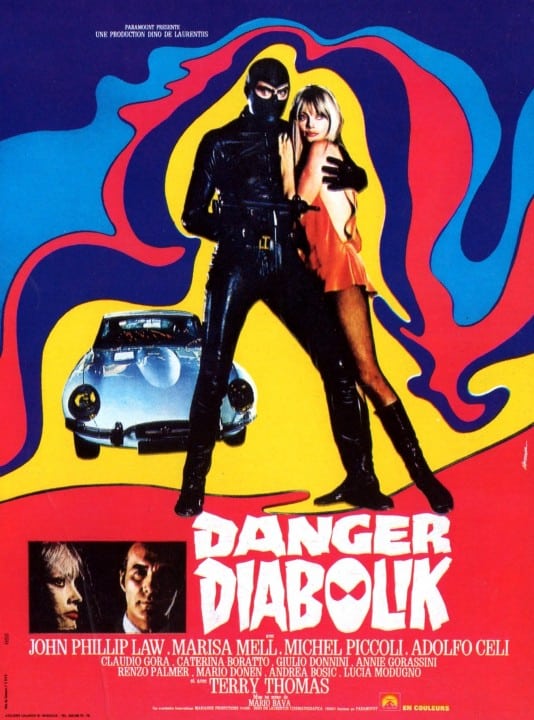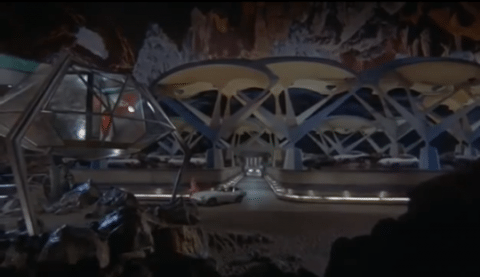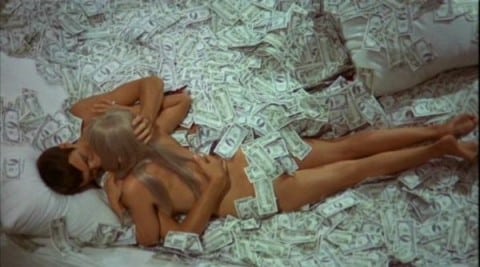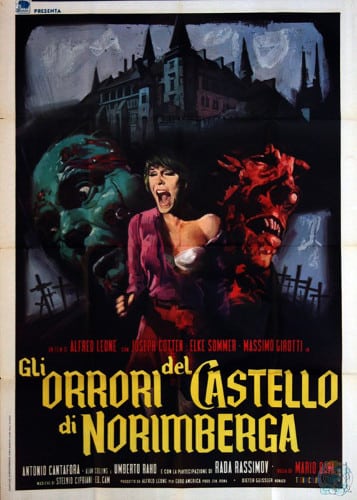Danger: Diabolik (1968)
Directed by: Mario Bava
Written by: Angela Giussani, Arduino Maiuri, Brian Degas, Mario Bava, Tudor Gates
Starring: Adolfo Celi, John Phillip Law, Marisa Mell, Michel Piccoli
HCF REWIND NO.259: DANGER: DIABOLIK [Italy 1968]
AVAILABLE ON DVD
RUNNING TIME: 105 min
REVIEWED BY: Dr Lenera, Official HCF Critic
Master thief Diabolik makes off with $10 million from an armoured car, prompting the Minister of Finance to bring back the death penalty and grant the frustrated Inspector Ginko the special powers he needs to catch him. This affects the criminal underworld, prompting gangster boss Ralph Valmont to contact Ginko and make a bargain to catch Diabolik alive, aided by Ginko. Ginko’s bait of some priceless emeralds is too enticing for Diabolik to ignore, as he needs a birthday present for his lover-accomplice Eva Kant….
This hugely entertaining piece of 1960’s kitsch, one of the best early comic book movies, seems like an atypical project from Mario Bava, mostly associated with Gothic gloom and morbid themes, though he did make quite a few non-horror films [and I shall gradually examine them all in due course] in genres such as the western and the historical drama, while there is often both a wry sense of humour and a very black comedic edge to even some of his darkest projects. Nonetheless, the constant jokey feel, light touch and sunny air to Danger: Diabolik still seem quite surprising when set against Bava’s other work, yet Bava seems totally and utterly at home with this kind of thing and totally interested by, and committed to, the material. Watching it for only the second time [yes, it took me far too long to submit myself to the great pleasure of seeing this film], I wished that the man had made more films like it, though it retains the inventive visual style and even some of the familiar themes common to Bava, and actually just before Danger: Diabolik he’d made the vaguely similar Dr. Goldfoot And The Girl Bombs, though that science-fictional comedy was a complete failure and possibly Bava’s worst!
Diabolik was a character created by sisters Angela and Luciana Giussani in 1962, and published in small [12 x 17 cm] monthly black and white comic books to great popularity in Italy. Producer Dino de Laurentiis intended his film version to be a partial follow-up to the hugely successful Barbarella. Jean Sorel, and, after brief consideration of unknown model Charlie Bluhdorn, Catherine Deneuve were intended to be the leads, but after a few days of filming Sorel was considered to be inappropriate for the role and Deneuve objected to removing her clothes for a [tastefully shot] love scene [she obviously changed her mind soon after for Belle De Jour], so Barbarella’s John Phillip Law and Marisa Mell replaced them. Danger: Diabolik was made at a time when some creators of supposedly violent and sadistic comics were on trial, therefore De Laurentiis, who overruled Bava on many things, toned down much of the blood and brutality of the Diabolik comics. Bava felt ill at ease with what was a far larger scale production, and longer shooting schedule, than he was used to, and, though given $3 million to work with, brought the film in massively under budget at $400 000. In particular, he used cardboard cut-outs glued to glass instead of some of the sets. The film was a huge success in mainland Europe but virtually flopped elsewhere. The UK version lost 13 minutes of chiefly dialogue scenes [probably making the plot virtually incomprehensible], the US cut lost a few shots here and there, while for many years the only English-language version available was a poor dub featuring many alternate voices. Having not enjoyed working with De Laurentiis, Bava turned down his offer to make a sequel. Rumours abounded a few years ago of a remake, and it has inspired music videos by the Beastie Boys [using original clips] and Tiromancino.
The film gets going straight-away with a daring robbery and escape, than a very odd scene where Diabolik and girlfriend/helper Eva sneak into a press conference and reduce everyone but themselves to laughter by setting off some exhilarating gas, protecting themselves by taking anti-exhilarating pills. The gas and the pills are both marked ‘gas’ and ‘anti-exhilarating pills’, and indeed we are not far from the Batman TV series in parts of this frequently outlandish movie, or even a Tex Avery cartoon. Our hero and heroine return to their lair, and we are given time to bathe in the strange design schemes. You can just about tell that some of the interiors are cardboard cut-outs, but I’m saying that because I knew this about the film second time round, so it may not be that obvious on a first viewing. The couple make love on a huge revolving bed, buried under hundreds of dollar bills. It’s as succinct a filmic illustration of greed, waste and decadence as you can get, though Diabolik’s and Eva’s relationship is of a much healthier sexuality than you often get in Bava’s work. Unlike most of Bava’s outsider leading characters, they’re people who are cool and who you want to be like.
The authorities fret around trying to catch Diabolik, and the cops even team up with gangsters, though Diabolik outwits them virtually every time. Like many European comic books and even some very early comic book films, the villain, despite being a thief who certainly doesn’t give to the poor, is really the hero, or at least the guy you want to prevail, and this one boasts much Bond villain-type gadgetry including a Blofeld-on-a-budget underground lair. The authority figures, especially Terry-Thomas being Terry-Thomas as only he could, are all buffoons and even Valmont, even if he does like to shoot his employers [there’s a funny scene where he accedes to someone’s request not to be shot and presses a button so part of the bottom of the plane they’re in falls out and the man falls to his death], spends most of his time surrounded by pretty women, is pretty ineffectual. The film doesn’t really give us a lot of action scenes. People who see Diabolik: Danger as a film influenced by the Bond films [and it’s easy to do when you get a scene of Diabolik scaling a wall using suction-cups like the ones 007 used in You Only Live Twice, though this, as with many scenes in the film, was actually taken from one of the comics] are invariably disappointed with the way it doesn’t really make the most of its thrills, like a skydiving brawl between Diabolik and crime kingpin Valmont. The film does move fast though and briefly takes a darker tone when Eva is kidnapped and tortured [though mostly off-screen]. Diabolik’s comeuppance, literal consumption by greed or wealth, of is a perfect example of poetic justice, but the film ends with a wink and it really feels like Diabolik will get out of his situation.
Danger: Diabolik partly seems to explore things like the generation gap [it clearly prefers the vibrant, sexy young] and even includes an early 60’s psychedelic party scene with people passing around a huge joint and sporting paint face paint and colourful costumes, its effect enhanced by image-distorting lenses, weird lightning and weirder music. The whole thing has a wonderfully cool, anti-authoritarian vibe which ensures that it seems to perfectly encapsulate the feel of the time it was made in as much as films more obviously set in that time period [despite things like American dollar bills, and being filmed in Italy, Danger: Diabolik seems to be set in its own strange world even if it’s reflected through the 60’s of Italy and American]. Meanwhile Bava constantly employs unusual angles, staging and cuts in imitation of the comics, and succeeds where many early makers of comic book adaptations failed in replicating their feel. This is because the common thing was to use static tableaux, while Bava actually tries to copy what the comic book pictures try to do and transfer that into cinematic terms. Sadly the visual side of the film is let down by some very poor back projected scenes [hinting at rushed reshoots maybe?], and in the end it does perhaps fall just a little short of what it could have been, while the shadow of Austin Powers can’t help but fall on any film like this, especially one that has a scene where Diabolik and Eva [wearing an obvious body suit] are in the shower and their privates are conveniently obscured by portions of the glass!
The two leads were obviously chosen for their looks more than their acting ability, but Adolpho Celi, though dubbed with a different voice, does a solid retread of his Emilio Largo from Thunderball. Though the title song isn’t too well sung by ‘Christy’ and repeats the words: “deep deep down” rather too often, Ennio Morricone’s often crazy, trippy score is a major highlight with its bizarre instrumentation and groovy riffs. There’s a particularly great fusion of music of images in an underwater heist scene when a gorgeous lyrical theme, with Edda Dal’ Orso’s typically haunting wordless vocalising, suddenly becomes a livelier and very catchy piece straight out of a spaghetti western. Though it has a few flaws to it, Danger: Diabolik is terrific fun from beginning to end and shows some different pathways Bava’s career may have gone down if he didn’t like making horror movies so much [or, perhaps more accurately, it wasn’t continually expected of him!].
Rating: 

















Be the first to comment